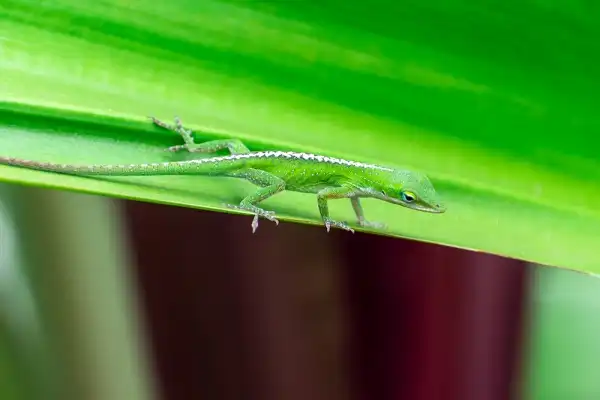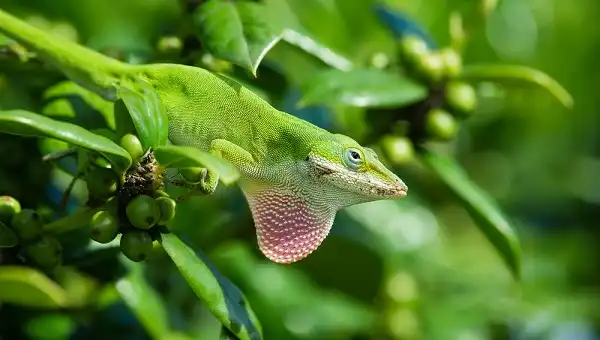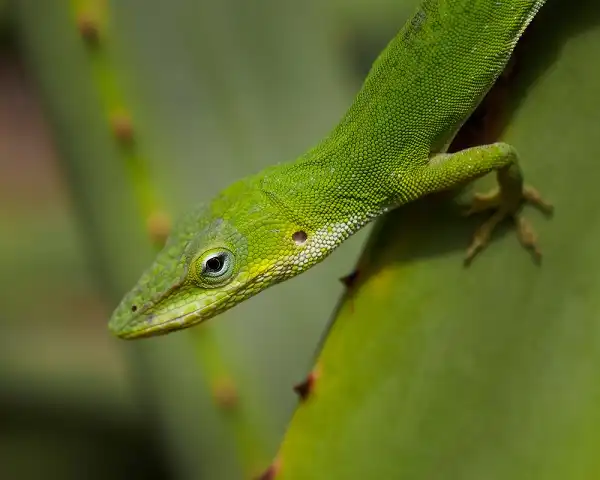Are you looking for a unique, eye-catching pet to add some life and fun to your home? If so, then consider the green anole! This small lizard is native to the southeastern United States but has also established itself in parts of Europe and even Hawaii. Green anoles are active little creatures that will bring plenty of personality into your life. They are easy to care for with minimal requirements making them a great beginner pet reptile. Keep reading to learn everything you need to know about keeping this special creature as a pet!

Green Anole Description
Green anoles are small lizards with a unique appearance. They have a slim body shape, their skin is usually green or brown in color, and they have bright red dewlaps on their throats. Their heads are triangular in shape, and they also have long tongues that they use to catch prey. Green anoles typically have smooth scales which can sometimes be seen as ridges along their backs. They have four limbs and their toes end in adhesive pads, giving them the ability to climb walls and other vertical surfaces. The claws on their feet help them grasp branches when climbing trees or navigating obstacles. Green anoles also have a special camouflaging ability that helps them blend into their surroundings when threatened or hiding from predators. Their coloring will change from green to brown depending on the type of environment they’re in, making it difficult for potential predators to spot them easily.
Green Anole Habitat
Green Anoles are typically found in warm, humid climates such as those found in the southeastern United States. They thrive best in areas that have light foliage and plenty of trees for them to climb. Their natural habitats include woodlands, swamps, and forests with plenty of leafy cover. In captivity, Green Anoles can thrive quite easily since they don’t require any special lighting or heat sources. Green Anoles prefer an enclosure that is at least 30 gallons (250 liters) with a secure lid and plenty of live plants to provide hiding spots. The substrate should be two to three inches deep and moisture retentive as these lizards love to dig around in it. The temperature inside the enclosure should stay between 75-82°F (24-28°C) during the day and cooler at night; humidity should be kept between 50-80% for their comfort.
Green Anole Diet
Green Anoles are insectivores, meaning their diet mainly consists of small insects such as crickets, mealworms, wax worms, and roaches. Additionally, they can also be offered small pieces of fruit such as apples or oranges as a treat. They eat 3-5 insects per day depending on their size and should always be given fresh food every day. If using live food sources, avoid feeding them wild-caught bugs as they may carry parasites or diseases. It’s best to always use commercially raised feeder insects which can be bought from pet stores. Green Anoles also benefit from a balanced vitamin supplement that provides all the essential nutrients needed for optimal health. The supplement should be dusted over their prey at least once a week to provide necessary calcium and other vitamins/minerals. Additionally, access to clean drinking water should always be provided in order to keep the lizard hydrated.

Green Anole Size
Green Anoles are small lizards, growing up to 8 inches in length. They have a slim body shape and can be green or brown in color. The claws on their feet help them climb trees and navigate obstacles, while the adhesive pads on their toes enable them to climb walls and other vertical surfaces. Their heads are triangular in shape and they have long tongues that allow them to catch prey. Additionally, they possess a special camouflaging ability that helps them blend into their surroundings when threatened or hiding from predators. Green Anole size is largely determined by its age, with younger anoles being significantly smaller than mature adults. Young Anoles typically measure around 3-4 inches in length, while adult Anoles can reach up to 8 inches in length when fully grown. Females tend to be slightly larger than males, but the differences are not usually conspicuous enough for an untrained eye to easily distinguish between sexes. In terms of weight, Green Anoles generally weigh around 2-3 grams at birth and increase in mass as they grow older; adult males average at around 6-7 grams while females weigh slightly more at 7-8 grams on average. It is important for pet owners to monitor their pet’s weight as obesity can lead to health problems such as metabolic bone disease and respiratory infections.
Green Anole Lifespan
Green Anoles typically have a lifespan of up to 5 years in captivity, although some may live longer. In the wild, their lifespan is usually shorter due to predation and other factors. When kept as pets, Green Anoles need proper nutrition and care in order to help them reach their full lifespan potential. This includes providing a healthy diet with plenty of insects and supplementing it with vitamins/minerals, access to clean water, and an appropriate environment with temperature and humidity levels that suits their needs. Additionally, regular vet checkups are recommended in order to detect any health issues early on so that they can be treated promptly.
Green Anole Behavior
Green Anoles are generally active during the day and prefer to stay in their own territory, marking out their area with secretions from glands located near their eyes and cloaca. They can usually be found basking in the sun, climbing trees, or running around on the ground. When threatened, they will puff up their throat region to appear larger and more intimidating; if this doesn’t work they may drop off of a branch or try to flee quickly. Green Anoles are solitary creatures mostly seen alone but can often be spotted in pairs during the breeding season. During this time, males become particularly territorial as they compete for access to females and mark out their territories using secretions from glands near their eyes. They also engage in a behavior known as “head bobbing” which is when they bob their heads up and down while simultaneously arching their backs and displaying colorful dewlaps on either side of their neck. This is meant to showcase dominance towards other males or attract potential mates.

Green Anole Speed
Green Anoles have quite an impressive speed, with the ability to reach up to 6 feet per second when escaping predators. This is about five times faster than the average human walking pace! On top of that, they can also make quick turns and maneuver around tight spaces with ease due to their slim body shape. Additionally, the adhesive pads on the ends of their toes help them climb walls and other vertical surfaces quickly. When it comes to ground movement, Green Anoles use a combination of running and leaping. They have the ability to jump up to 2 feet in one leap, which allows them to cover large distances quickly. This type of locomotion is known as saltatory locomotion and is commonly seen in small animals such as lizards or frogs.
Green Anole Reproduction
Green Anole reproduction typically takes place during the warmer months of the year. Males will engage in a behavior known as ‘head bobbing’ which is when they bob their heads up and down while simultaneously arching their backs and displaying colorful dewlaps on either side of their neck. This is meant to showcase dominance towards other males or attract potential mates. Once a male has successfully won over a female, mating usually occurs in one of two ways: Arboreal, where the pair will mate while perched on a tree branch, or Terrestrial, where mating can take place either on the ground or on top of vegetation. During the breeding season, females tend to lay clutches of eggs approximately every two weeks and can produce anywhere from 2-14 eggs in total. The eggs are usually laid in moist soil beneath rocks or logs and are about the size of a pea. They hatch after around 3-4 weeks and young anoles typically measure around 1-2 inches in length at birth. As they grow older, green anole size is largely determined by its age; younger anoles are significantly smaller than mature adults.
Green Anole Hunting
Green Anole hunting is a fascinating process that requires a keen eye and a lot of patience. Green Anoles are well-adapted for swift movement, making them difficult to catch with bare hands. They possess adhesive pads on the ends of their toes that allow them to quickly scale walls and other vertical surfaces, as well as special claws which help them climb trees or navigate obstacles with ease. Additionally, they are able to change color between green and brown based on environmental factors – making them almost invisible to predators in certain settings. When hunting Green Anoles, it helps to be aware of their behavior patterns so that you can better anticipate where they will go next.
Some tips include paying attention to areas where the sun is shining or plants are swaying, as this may indicate where an anole is likely to be found basking in the warmth or hiding in the shadows. It is also helpful to watch for signs of head bobbing behavior which indicates aggressive territorial marking or courtship rituals. In order to actually capture a Green Anole, it’s best to have some sort of catch net or cage trap handy. This will allow you to safely secure your target without damaging it or causing harm in any way. Also, keep in mind that these lizards have incredibly fast reflexes and can make quick turns so it may take several attempts before successfully snaring one! Once you do manage to get hold of one, it should then be placed into a secure enclosure such as an aquarium tank with plenty of ventilation and natural elements (branches, rocks, etc.) for climbing and hiding purposes.

Conclusion
Green Anoles are fascinating creatures that not only make for great pets but also offer a unique opportunity to observe and learn about animal behavior. By understanding the various traits and characteristics of Green Anoles such as their speed, reproductive patterns, hunting habits, and color-changing ability, we can gain deeper insight into the natural world around us. Whether you’re a novice reptile enthusiast or an experienced herpetologist, Green Anoles provides endless entertainment and educational opportunities!
Frequently Asked Question
Is a Green Anole poisonous?
No, Green Anoles are not poisonous. They do not produce toxins or venom that pose a threat to humans or other animals.
What do Green Anoles eat in the wild?
In the wild, Green Anoles primarily eat small insects like crickets, flies, ants, and spiders. They are insectivores and rely on hunting to fulfill their dietary needs.
What are common health issues in Green Anoles?
Common health issues in Green Anoles include metabolic bone disease, respiratory infections, parasites, and dehydration. Proper husbandry and regular veterinary check-ups can help prevent and address these problems.
How do Green Anoles reproduce?
Green Anoles reproduce through sexual reproduction. Males display courtship behaviors and perform elaborate rituals to attract females, who then lay eggs after mating.


